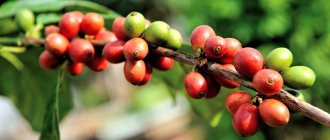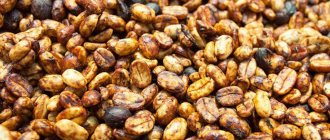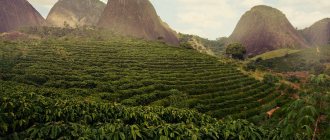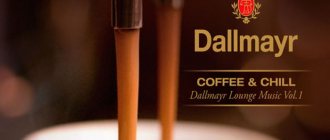Many coffee lovers appreciate their favorite drink for its bitter taste. There are also those who do everything possible to eliminate this flavor. It was previously believed that the more caffeine, the stronger the bitterness. Scientists have been able to prove that there is no connection here. Nevertheless, it is worth understanding why coffee from a coffee machine or Turkish coffee tastes bitter and what affects the intensity of the taste.
The most correct and delicious coffee is in Italy
Italian espresso appeared during the Industrial Revolution, when managers of large industries decided to shorten the pauses for “drinking coffee.” The first espresso, in the form in which we are accustomed to seeing it, appeared in 1938, thanks to Achille Gaggia’s machine. And I must say, they accepted this espresso with a creak and reluctance, because before the development of Gaggia, coffee machines produced something like the current filter - all the water in the drink passed through a portion of ground coffee under slight pressure, and not 9 atmospheres, as now. The result was a fairly large cup of black coffee without cream (coffee foam - ed.). That is, it turns out that the Italians, in their characteristic manner, cursed, demanding their normal coffee, and did not want to drink this strange thick liquid from the cream, about 30 ml in volume. How ironic life is.
However, the current coffee culture exists largely thanks to Italy. At one time, Howard Schultz, CEO of the great and terrible Starbucks, fascinated by the image of the barista, brought the ideology of espresso bars to the USA, and what happened happened: today we all know who baristas are, whether we love them or are afraid of them. And at the beginning of my career they called me a coffee salesman. To put it mildly, there is a lot to be grateful for.
But why shouldn’t we hold on to the image of Italian coffee as the only true constant? Because the whole world picked up the theme of espresso bars and by 2020 brought it to incredible depth and breadth. On a botanical level alone, coffee has undergone incredible changes. More and more new hybrids and mutations of coffee trees are appearing, with amazing characteristics and flavor potential. Enthusiasts and farmers are endlessly experimenting with green grain fermentations. All sorts of “correct” fertilizers (fertilizers - ed.) are used to help the trees. Programs to conserve soil and water resources are being implemented. Overall, the diversity of species combined with unique terroir conditions is like a space map in Star Trek. And all this became possible thanks to the huge demand for a high-quality, meaningful and traceable product, and not some bitter and invigorating noname.
Considering how coffee itself is changing, the entire consumption culture is changing. The current job of a barista is difficult and responsible. You need to have deep theoretical knowledge and honed skills in order to make quick and correct decisions, because a cup of coffee in a modern coffee shop is a whole science, and not just a cozy environment. There is even a worldwide association that holds large-scale and vibrant competitions between baristas in different disciplines, which greatly influences the annual growth of professionalism.
https://www.facebook.com/biz.nv.ua/photos/gm.857013781387620/2777300449179698/?type=3&theater&width=500&show_text=true&height=446&appId
You can imagine that the barista behind the counter who gives you your latte every day is planning her work schedule so that this month she can compete in, for example, an alternative coffee brewing championship, get an international certification, or even go to the plantations to Central America to study all the processes of coffee production? This is exactly what is happening now. Not everywhere, but more and more often, although five years ago this would have been difficult to imagine.
For this reason alone, the generally accepted image of traditional Italian coffee does not correspond to trends - we should forget about this stereotype and look at the product and culture more broadly. But, of course, this does not mean that coffee in Italy is necessarily wrong and tasteless: there are already enough excellent modern enthusiasts there, both among roasteries and among coffee shops.
Country of origin
Coffee naturally differs not by the brand name (Lavazza, Illi, Black Card) and not by the country where it is roasted and packaged, for example Russia, Italy or France, which also of course brings its own characteristics, but mainly by regions and places where the varieties grow. All types of coffee are different in their flavor notes, but of course the main recognizable taste is coffee, it unites everything. But let's go over and characterize the characteristics of coffee from different countries.
Coffee notes of tastes of different countries and regions of growth:
Country/Region - Flavoring Notes
- Indonesia - cocoa, spices, herbs, nuts, prunes, wood, smoke
- Sumatra - nuts (walnuts, peanuts), baked goods (vanilla, butter, spices), citruses (lemon, orange, lime, grapefruit), fresh wood
- America - orange and yellow citrus fruits, tropical yellow and green fruits (melon, mango, pineapple, apricot, dates), medium-bitter chocolate (cocoa, fig, spices, tea notes), cashews, almonds, wild berries (drupe, blueberry) , strawberries, raspberries)
- Brazil - chocolate, nuts, spices, fruity acidity
- Salvador - dark chocolate, bitter almonds, apricot kernels, apple, jasmine
- Guatemala - dark chocolate, herbs, cereals, vanilla, green apple, caramel
- Colombia - apple, tropical fruit (pineapple), lemongrass, pear, maple syrup, cookies, nuts
- Honduras - dark chocolate, almonds, black currants, cherries, watermelon
- Costa Rica - berries, bread and candied fruits, white grapes, blackberries, dark chocolate
- Africa - wine and grapes, citrus fruits, flowers (jasmine, bergamot), red and orange tropical fruits (papaya, melon, dates), red berries (cranberries, lingonberries, currants, strawberries, strawberries, cherries), midland fruits (pears, apples, plums); caramel, cocoa, pastries, sweet nuts and spices
- Uganda - caramel, chocolate, orange, grapefruit zest, flowers, blueberries, cream, dark honey
- Burundi - pomegranate, dried apples, prunes, dried apricots, chocolate, licorice
- Ethiopia (washed) - grapes and wine, flowers and warm spices, bergamot and jasmine, chocolate, red berries
- Ethiopia (dry) - cherries, blueberries, blackcurrants, blackberries, cumin, nutmeg, chocolate and cream, honey, raisin cookies
- Kenya (washed) - herbs (marjoram, thyme, mint), caramel, dried fruits, blackberries, apples, fresh baked goods, cognac, smoke
- Kenya (dry) - chocolate with pepper, tropical fruits (pineapple, melon), candied oranges, red apples, ripe gooseberries, persimmons, red pepper, cinnamon, baked apples, vanilla
Coffee is harmful - it negatively affects the cardiovascular system, kidneys and washes away calcium
Caffeine is not a product for energy drinks and Coca-Cola, but for coffee trees, which need it to protect themselves from insects. A natural insecticide, in other words. For us, caffeine is an alkaloid and nootropic. But it’s invigorating – that’s not really what it’s about.
A cup of coffee, depending on the quality of the raw materials and the nuances of preparation, contains an average of 100 mg of caffeine. 1 g of caffeine (10 such cups of coffee) is considered a potentially dangerous dose, and 10 g is considered fatal.
Approximately 20 minutes after entering the body, caffeine enters the circulatory system, overcomes the blood-brain barrier and begins to affect the central nervous system. This is where things get interesting.
We are informed about the feeling of fatigue by a bio-push notification - adenosine. Roughly speaking, it makes it clear to the body that strength is running out and it’s worth taking a horizontal position as soon as possible - but here’s another 20% charge for you so that you can find a cave and light a fire in it.
So, caffeine is so quick and small that it simply takes the place of adenosine, not allowing it to deliver the necessary message to the brain. If the situation repeats itself, tolerance develops, the body releases even more adenosine, and if you pour more and more generous portions of caffeine in order to wake up or stay asleep, sooner or later you will have to take a proper rest. After all, coffee does not replenish resources. It just tempts you to use the rest recklessly. But if you drink four cups of coffee without Robusta per day (it has almost twice as much caffeine), and not all at the same time before bed, then most likely you will not notice anything - unless you take into account the individual characteristics of the body. Or rather, you will notice, but not immediately, and the effect can be very positive.
Observational studies suggest that those who drink 1 to 4 cups of coffee per day live longer than those who do not drink it or drink very large quantities. Regular consumption of 1 to 4 cups of coffee is associated with an 8-17% increase in life expectancy, and, importantly, this is not associated with genetic metabolic characteristics. That is, regardless of how quickly the body copes with caffeine, the indicator will remain unchanged.
This can be summed up
- Coffee must be freshly roasted or no older than 3 months after roasting.
- After opening the package, it is advisable to use the coffee within a week, maximum two, otherwise the taste and aroma will be lost.
- For automatic coffee machines, the optimal roast is medium roast, which looks like brown dry matte beans.
- The fullest bouquet of coffee flavor is revealed at medium roast.
- There are not only expensive Arabicas, but also excellent Robustas, this is the name of the types/grades of coffee - try the taste.
- Pure Arabica usually has a pronounced sourness, Robusta has a bitterness.
- You can use both blended and single-origin coffee - a matter of preference.
- Blended Arabica coffee hides excess sourness, while Robusta coffee hides bitterness - resulting in an aromatic and rich taste.
- Flavored, wet or fatty coffee should not be used in automatic coffee machines.
- If you need ground coffee, it is better to grind it yourself, immediately before preparation.
Coffee with milk has less caffeine. Americano is not as strong as espresso
The basis of any classic milk drink is espresso. This is a certain solution that is formed when interacting with water. Water acts as a solvent in this interaction, and some of the substances - those that are insoluble - are washed away mechanically. So, if you add an additional ingredient, for example, milk, to the finished solution, the original ingredients from the solution will not go away. And this also applies to caffeine. If you add milk to a bucket of water with sand, the sand will not disappear from there. The same thing happens with lattes.
And with Americano it’s even simpler: by adding water to espresso, we simply dilute the original solution and change its concentration.
Secrets of proper tasting
“If you want to choose your own coffee, it is better to take several blends of the same grind and brew them in the same way, this will make it easier for you to determine the most suitable flavor notes for yourself and then look for coffee grown, for example, in the same region,” says Marketing Director of one of the largest coffee producers in Russia, the Finnish company Paulig, coffee expert Alexander Kopytov
.
Professional coffee tasting consists of simplicity and adherence to one coffee preparation recipe for the whole world: 13 g of coarse coffee, like sugar, ground, brewed in a 200 ml cup with hot water at a temperature of 94 ° C for 4 minutes. Then the coffee cap on the surface is mixed with the total mass of the brewed drink and everything remaining on the surface is removed with a spoon. After 1.5-2 minutes, when all the coffee particles have settled at the bottom and the drink has cooled down a little, you can begin tasting.
Kopi Luwak and Blue Mountain
If you believe the legend that there is an unusual enzyme in the stomachs of the cute Luwak animals that preserves the amazing taste of coffee, then perhaps this would be interesting - if this coffee was not sold as a souvenir in an extremely dark roasting style. The fact is that intensive heat treatment destroys complex protein compounds - enzymes, or enzymes, which are responsible for the formation of the most subtle and interesting flavors. It is thanks to them that all kinds of plant notes are formed: fruity, berry, floral, and, in fact, it is they that determine the uniqueness of a particular variety. Why preserve the taste characteristics with the help of animal enzymes, only to then destroy them through ill-considered processing? The obvious conclusion is obvious.
Blue Mountain is notable because it was actually the first high-altitude, high-acid coffee to become popular. Thanks to marketing, of course. Now there is no point in buying such coffee, given all the amazing variety of varieties and the range of their tastes. And not at all at Blue Mountain's price.
Conclusion:
- Coffee is bitter not because of caffeine, but because of chlorogenic acid derivatives that are released when the beans are roasted.
- The darker the roast, the more bitter the coffee will taste.
- Robusta is more bitter than Arabica.
- Instant coffee is not bitter, since the substances that impart bitterness are boiled out of it.
- Decaffeinated coffee is almost as bitter as regular coffee, the difference in taste is imperceptible.
- To reduce the bitterness, you can add a little salt to the drink, simmer it in a pot over low heat, or try pouring it into a dark cup.
PS Snobs work in Ukrainian coffee shops
Ukraine has the most open, proactive and versatile specialists. At any international exhibition this is always obvious. It so happens that coffee in Ukraine has recently become a mass drink, and there are no deep roots of tradition in our memory - and it is precisely because of this that we are flying at the speed of light towards new ideas and cultural revolutions. There is no doubt that it is the Ukrainian professional community that will be at the head of the leading composition of global innovations and bold projects.
Join our telegram channel
Opinions NV
More blogs
here
Variety
Apples are one of the best examples of how variety plays a role in terms of preference. Almost everyone loves apples, but tastes and preferences differ when choosing a variety.
Common coffee varieties and Arabica varieties are Bourbon, Typica and Caturra, etc. This is also a big topic; we will provide short reference descriptions.
- Typica is the starting variety for breeding many varieties of coffee. This variety grew naturally in Ethiopia and was first described as the species coffea arabica L. by Linnaeus. In the 18th century, the variety was brought from Ethiopia to many colonies. Typica is characterized by excellent fruit quality, but low yield and large crown size (which reduces the number of plants per unit area).
- Bourbon was first discovered in Ethiopia and is a spontaneous mutation of Typica. The French introduced the variety in 1708 to their colony on Bourbon Island (now Reunion), and from there the variety gradually spread to other countries, including El Salvador, Brazil and Mexico. The productivity of this variety is 20-30% higher than that of Typica, but lower than that of other varieties. The quality of Bourbon fruit is comparable to that of Typica.
- Mundo Novo is a natural hybrid of Typica and Bourbon. It was first discovered in Brazil in the 40s of the last century. The variety is characterized by high yield and disease resistance.
- Caturra is a relatively new mutation of Bourbon, discovered in the 30s of the last century in Brazil, near the city of Caturra. This variety has high yield and resistance to disease, but is inferior in quality to Typica and Bourbon.
- Maragogype is a mutation of Typica, discovered near the city of Maragogype in Brazil. This variety has a low yield, but produces the largest, but quite porous grains.
- Blue mountain is a unique mutation of Typica native to the Blue Mountains of Jamaica. This variety is distinguished by its ability to grow at high altitudes above sea level. The taste qualities of this variety are very highly valued by coffee lovers.
Shopping Expert
In stores and supermarkets you can find coffee of different price categories from different manufacturers, but in order to buy good quality natural coffee you need to know some nuances.
Coffee beans
The raw materials for all types of coffee are the fruits of two coffee trees - Robusta and Arabica (they are cultivated and processed on a global scale). Robusta grains are round in shape, small and have a straight groove; from them a drink with a high caffeine content is obtained, with an astringent, simple and rough taste and excessive bitterness. Arabica beans are large, oblong in shape with a curved groove; The taste of this type of coffee is noble, intense, rich. The best variety of coffee is 100% Arabica; its price is high and is due to the vagaries of growing trees (they require careful care and bear fruit less often), while Robusta is unpretentious and produces more than 8 harvests per year. In order to save money, unscrupulous producers mix Arabica and Robusta beans, producing coffee of low quality and price range.
Opt for coffee beans or ground (they are considered the most aromatic and tasty). Instant coffee cannot be considered high-quality, because in the production of this product preference is given to low-grade raw materials, represented by splinters and fragments of grains, and more resourceful manufacturers introduce various additives in crushed form into the drink mixture: oats, chicory, barley, acorns. The naturalness of the drink will be indicated by the mark on the packaging “100% instant coffee”.
Instant coffee
There are several variations of instant coffee. The production process is represented by two stages: brewing and evaporation of the coffee mass (this takes several hours). It should be noted that at the initial stage of production, roasted and ground coffee beans are boiled in sealed vessels until a coffee syrup with a thick consistency is formed. From this point on, differences begin in the preparation of different types of instant coffee.
Roasting degrees
According to a simplified classification, the manufacturer offers light, medium and dark roast coffee.
- Light roast coffee has a faint bready aroma and rich acidity. It has a milder taste and costs more. Goes great with milk and cream.
- Medium-roasted grains have a slight sourness and a characteristic caramel taste with herbal undertones. This roasting method is most often used for espresso.
- Dark roasting makes the drink more rich, dense and bitter. The sourness practically disappears, but a bright caramel aroma and smoky notes appear. This coffee leaves a long aftertaste.
Species differences
- Sublimated (frozen). Coffee crystals (sublimate) are obtained by freezing the brewed liquid and then evaporating it under vacuum. After which the already dehydrated mass is crushed, obtaining granules of irregular shape. The sublimate of a high-quality drink is dense, does not crumble, large, with sharp corners, and has a light brown color; In comparison with other types of instant coffee, we can say that it retains more nutrients and taste. The minimum percentage of caffeine in frozen coffee is 3% (this is a good indicator). There should be no coffee “dust” at the bottom of the package with such a product; if it is present, it means the production technology has been violated.
- Granulated. The resulting fine coffee powder is pressed with the addition of a small amount of moisture. This coffee has a porous structure; granules can have different shapes and sizes.
- Powder (emulsified). The production technology comes down to spraying coffee extract in a stream of hot air.











